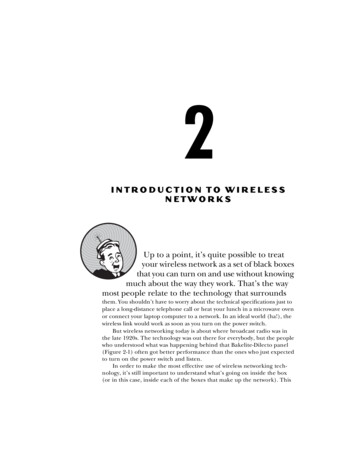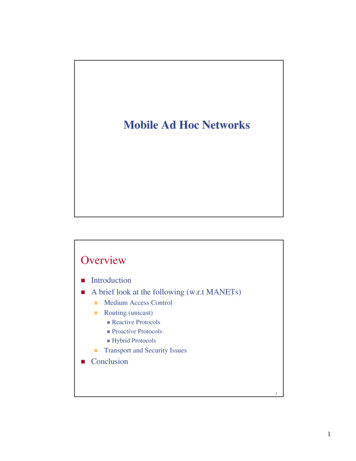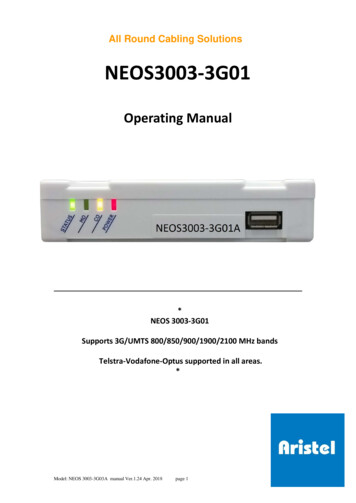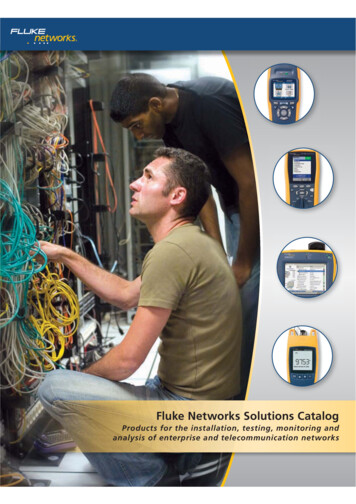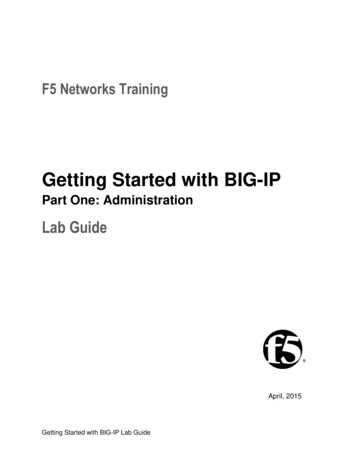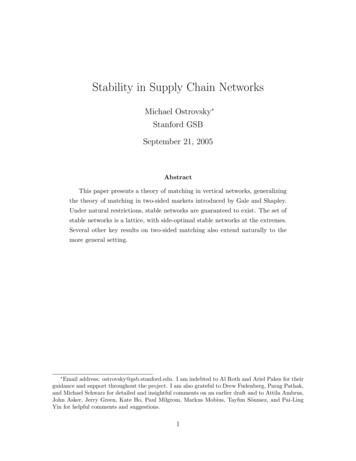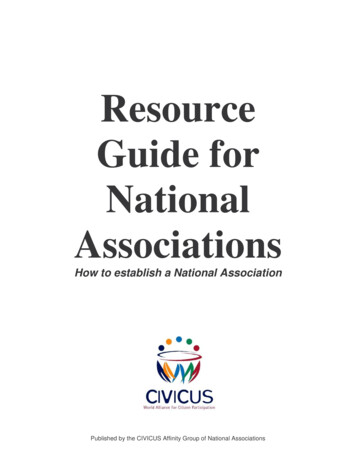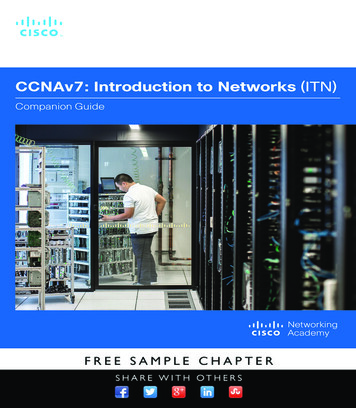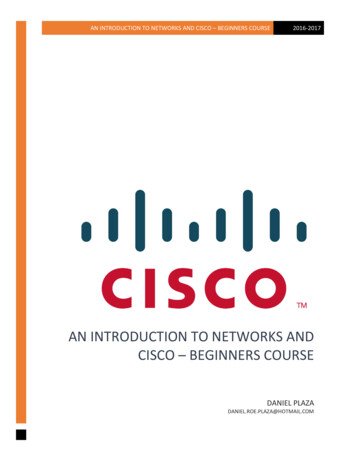
Transcription
AN INTRODUCTION TO NETWORKS AND CISCO – BEGINNERS COURSE2016-2017AN INTRODUCTION TO NETWORKS ANDCISCO – BEGINNERS COURSEDANIEL PLAZADANIEL.ROE.PLAZA@HOTMAIL.COM
An Introduction to Networks and CiscoThis page is intentionally left blank.i
An Introduction to Networks and CiscoTABLE OF CONTENTSCHAPTER 3 ITN – NETWORKING PROTOCOLS AND COMMUNICATION. 1-6Communication Fundamentals . 1Protocol Fundamentals . 1-2Network Protocols . 2-3Internet Standard Organizations . 4OSI and TCP/IP Model . 4-5Segmentation of Data . 5Protocol Data Units . 5-6IP Packet Header . 6Ethernet Frame Header . 6CHAPTER 7 ITN – IP ADDRESSES . 7-18IPv4 Address Expression . 7IPv4 IP Proportions. 8ANDING . 8Prefix Lengths . 9Types of Addresses in Network . 9Unicast, Multicast and Broadcast . 10IPv4 Address Blocks (Legacy). 10-11IP Address Assignment . 11IPv6 Address Representation . 12Omitting Leading 0s. 12-13Omitting All 0s Segments . 13IPv6 Address Types . 13IPv6 Link-Local Unicast Addresses . 14IPv6 Global Unicast Addresses . 14Configuring IPv6 on a Router . 14-15Stateless Address Autoconfiguration (SLAAC) . 15-16IPv6 Link-Local Addresses . 16-17Assigned IPv6 Multicast Addresses . 17ICMPv4 and ICMPv6 . 17-18CHAPTER 8 ITN – SUBNETTING . 19-32Reason for Subnetting . 19Octet Boundaries . 19-20Classless Subnetting with the /24 Prefix . 21-22Magic Number Technique . 22Assigning Subnets to a Router . 23-24Classless Subnetting with the/16 Prefix . 24-25Classless Subnetting with the /8 Prefix . 25-26Subnetting Based on Requirements . 26-28Traditional Subnetting Problem . 28Variable Length Subnet Mask (VLSM) . 28VLSM in Practice . 29-30Network Address Planning . 30-31IPv6 Global Unicast and Subnets . 31-32ii
An Introduction to Networks and CiscoTABLE OF CONTENTSCHAPTER 1 RSE – INTRODUCTION TO SWITCHED NETWORKS . 33-38Introduction to Switched Networks. 33Access, Distribution and Core Layers . 34Switch Form Factors and Requirements . 35General Concept of Switching . 36Switch Forwarding Methods . 37Collision and Broadcast Domains . 38CHAPTER 2 RSE – BASIC SWITCHING CONCEPTS AND CONFIGURATION . 39-54Preamble . 39Beginning of Switch Booting. 39Switch LEDs and Indicators . 40Configuring Basic Switch Management Access with IPv4 .41-42Duplex Communication.43-44Verifying Switch Port Configuration and Network Access Issues.45-46Basic Troubleshoot Concept in the Network Access Layer . 46Secure Shell (SSH) Operation and Configuration .47-48Common Security Attacks .49-50Network Security Practices .51-54Catch-up . 54CHAPTER 3 RSE – VLANS . 55-62Prologue . 55VLAN Terminology . 55Types of VLANs .55-56VLAN Trunks (Brief) . 56VLAN Tagging .56-57VLAN Implementation .57-58VLAN Trunks (Configuration) . 59Introduction to Dynamic Trunk Protocol (DTP). 60VLAN Troubleshooting . 61VLAN Attacks .61-62VLAN Design Guidelines . 62CHAPTER 4 RSE – ROUTING CONCEPTS. 63-76Preface . 63Network and Router Characteristics .63-64Packet Forwarding Mechanisms . 65The Assembly of a Network .66-67Configuration of a Router .67-69Expressions and Filters . 70Routing Switching Functions .71-72The Routing Table .73-74Assignment of Directly Connected Interfaces . 74Static Routing . 75Dynamic Routing . 76iii
An Introduction to Networks and CiscoTABLE OF CONTENTSCHAPTER 5 RSE – INTER-VLAN ROUTING . 77-84Foreword . 77What is Inter-VLAN Routing . 77Legacy Inter-VLAN Routing . 77Router-on-a-Stick . 78Multilayer Switch . 78Configuration of Legacy Inter-VLAN Routing . 79Configuration of Router-on-a-Stick Inter-VLAN Routing . 80Troubleshooting Inter-VLAN Routing . 81Introduction to Layer 3 Switching . 82Routed Ports. 83Configuring Static Routes on Catalyst 2960 . 83-84CHAPTER 6 RSE – STATIC ROUTING. 85-96Prelude . 85Static Routing Basics. 85-86IP ROUTE Command . 87Next-Hop Static Route . 88Directly Connected Static Route . 89Fully Specified Route . 89Default Static Route . 90IPv6 Static Route . 90Next-Hop IPv6 Static Route . 91Directly Connected IPv6 Static Route . 91Fully Specified IPv6 Route . 91Default IPv6 Static Route . 92Classful Network Addressing . 92-93Classless Inter-Domain Routing (CIDR) . 93Fixed-Length Subnet Masking (FLSM). 94Variable-Length Subnet Masking (VLSM) . 94Route Summarization . 95Route Summarization for IPv6 . 95Floating Static Routes . 96Troubleshooting Static Routes . 96CHAPTER 7 RSE – ROUTING DYNAMICALLY . 97-108Introduction . 97Dynamic Routing History . 97Static VS Dynamic . 98Dynamic Routing Protocol Operation . 98-99Routing Protocols. 99IGP, EGP, and AS . 100Distance Vector Routing Protocol . 100Link-State Routing Protocols .100-101Classful and Classless Routing Protocols . 101Distance Vector Technologies (RIP and IGRP) . 102RIP Configuration .103-105Link-State Technologies (OSPF and IS-IS).106-107The Routing Table .107-108iv
An Introduction to Networks and CiscoTABLE OF CONTENTSCHAPTER 8 RSE – SINGLE-AREA OSPF . 109-119Introduction to Open Shortest Path First . 109-110Link-State Operation . 110OSPF Messages . 111OSPF Operational States . 112-113Introduction to OSPFv2 . 113-115OSPF Cost . 115Verifying OSPF Neighbors . 116OSPFv3 Differences . 117Configuration of OSPFv3 and Troubleshooting . 118-119CHAPTER 9 RSE – ACCESS CONTROL LISTS . 120-129Introduction to Access Control Lists . 120-121The Operation of ACLs . 121-122ACL Wildcard Masking . 122-124Guidelines for ACL Creation . 124Standard and Extended ACL Placement . 125Criteria Statements . 126-127Extended IPv4 ACLs . 128Troubleshooting ACLs . 129CHAPTER 10 RSE – DHCP . 130-135Introduction to Dynamic Host Configuration Protocol . 130DHCPv4 Operation . 130-131DHCPv4 Message Format . 131-132DHCPv4 Server and Client Configuration . 132-134Troubleshooting DHCPv4 . 134-135CHAPTER 11 RSE – NETWORK ADDRESS TRANSLATION . 136-144Introduction to Network Address Translation . 136Network Address Translation Details and Terminology . 136-137NAT in Action . 137Static NAT and Dynamic NAT . 137-138Port Address Translation (PAT) . 138-139Benefits and Disadvantages of NAT . 139Configuration of Static and Dynamic NAT . 140-141Configuration of PAT and Port Forwarding . 142-144Troubleshooting NAT . 144I made this manual for the sake of my own note taking, referencing and help during competitions I may be a part of. Thisis not intended to be used as a book, but a reference to a couple particular chapters in Cisco Curriculum. Along with that,this book is not verbatim to the course material offered to me from http://netacad.com, some may be rephrased, but Ityped every single thing on here for my own need and for the need of others. Please don’t judge me for any mistakes,some information might be wrong, in that case, just send me what I need to fix.v
An Introduction to Networks and CiscoAll rights reserved to Cisco Systems Inc. These are just my own notes for Cisco for my own understanding.vi
ITN 3 – NETWORK PROTOCOLS AND COMMUNICATIONCommunication FundamentalsThe devices must have a common way of communication, for networks can be of any size, shape or form. For instances,humans use the following for communication (1) while computers use the following (2).1. Message Source Transmitter Transmission Medium Receiver Message Destination2. Message Source Encoder Transmitter Transmission Medium Receiver Decoder Message DestinationProtocol FundamentalsProtocols are used to establish a general ground for communicating, if one is not there, communication will be muchharder. The following requirements must be used with a protocol for successful communication: Ability to identify sender and receiverCommon language and grammarSpeed and timing of deliveryConfirmation or acknowledgment requirementsORMessenger Encoding - Encoding the information into another acceptable form for transmissionMessage Formatting and Encapsulation - When a message is sent from source to destination, it must use a specificformat or structure. It depends on the type of the message and the channel used to send it. When a message issent over a computer network in the format of a frame. Below is a frame reference.DestinationSource(MAC ADDR)(MAC ADDR)Frame Addressing Start FlagRecipient Flag Sender Flag(BEGIN)(DESTINATION) (SOURCE)Encapsulated MessageEncapsulatedData (BITS)Message Size - The messages are said in fragments or the sentences are limited to size. When a long message issent from one host to another, it’s necessary to break the message into smaller pieces and send the most it can ineach packet so that the original message will be created.Message Timing – Message timing follows a set of rules:o Access MethodAccess method determines when someone is able to send a message, if two people talk at the same time,a collision of information occurs and the people must start again. So. They both need to know when tobegin.o Flow Controlin network communications, source and destination hosts use flow control methods to negotiate correcttiming.o Response TimeoutIf a person asks a question and does not hear a response within an acceptable amount of time, theperson acts accordingly and may either repeat the question/request or end the conversation. Thishappens in networking.Message Delivery Options - There are three different types of delivery options among a network. Unicast, meaninga message is meant for only a single destination. Multicast, meaning it’s for more than one host, it can send tomultiple hosts simultaneously. Broadcast, meaning it’s sent to everyone among the network. Some protocols usea special multicast that is sent to all devices, basically making a broadcast. Hosts may be required to acknowledgethe receipt of some messages while not needing to acknowledge others.NETWORKING PROTOCOLS AND COMMUNICATION – CHAPTER 3 ITN1End of Frame(END)
An Introduction to Networks and CiscoWhen a group of inter-related protocols necessary to perform a communication function is called a protocol suite.Protocol suites are implemented by hosts and networking devices in software, hardware or both. The style that it mayfollow would be the following:CONTENT LAYER - The message within the frame.RULES LAYER1. Use a common language – This means use the same protocol as the source or destination.2. Wait your turn – This means detect if another device is already transmitting or not, this is called Carrier Sense.3. Signal when finished – This can be compared to the TCP handshake.PHYSICAL LAYER - How will we physically communicate?Network ProtocolsFor devices to successfully communicate, a network protocol suite must be described with precise requirements andinteractions. All of these protocols will belong to different categories, such as network, transport, etc. But there are someimportant things that we need to clear before we can begin to talk about protocols.How are messages formatted and structured? Saying
ITN 3 – NETWORK PROTOCOLS AND COMMUNICATION NETWORKING PROTOCOLS AND COMMUNICATION – CHAPTER 3 ITN 1 Communication Fundamentals The devices must have a common way of commu

